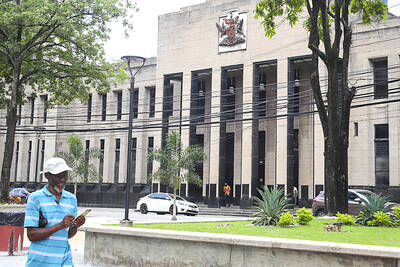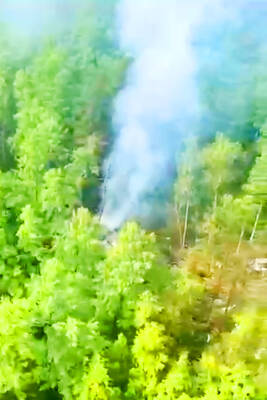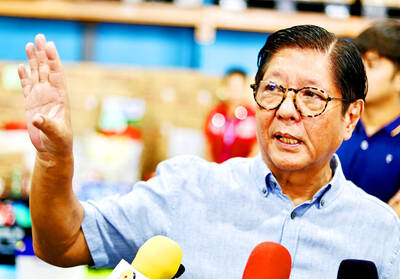Six more bodies were recovered from the Atlantic Ocean where an Air France jet crashed, Brazilian officials said on Friday, as the race to find the plane’s black boxes and gather key evidence from human remains and debris gained urgency.
On the coast, investigators examined corpses and received the first wreckage: two plane seats, oxygen masks, water bottles and several structural pieces, some no bigger than a man’s hand.
Almost two weeks after the crash, Brazil’s military said the search was becoming increasingly difficult and a tentative June 25 date for halting efforts had been set.
Beginning tomorrow, officials will meet every two days to evaluate when to stop the search depending on whether they are still finding bodies or debris.
The black boxes — whose emergency locator beacons begin to fade after 30 days — along with debris and bodies from the jet, all contain crucial clues as to how and why Air France Flight 447 went down en route from Rio de Janeiro to Paris.
Navy Vice Admiral Edison Lawrence said the Brazilians “have information” that a French ship has found six more bodies — which would bring the total found to 50.
William Waldock, who teaches air crash investigation at Embry-Riddle Aeronautical University in Prescott, Arizona, said the ability for a body to float in water depended on water temperatures and sea life in the area.
In water temperatures like those in the search area, Waldock said an intact body could likely float for two to three weeks.
Medical authorities examining the 16 bodies already brought on to land in Recife have declined to release information about the state of the corpses.
Meanwhile, military ships and planes continued to struggle in worsening weather to find more bodies and debris. Brazilian ships didn’t pick up more bodies on Friday, but they did find more debris, the details of which weren’t disclosed.
The most important piece recovered to date is the virtually intact vertical stabilizer, which could give the French investigative agency BEA solid clues about what prompted the crash.
“The debris will be at the disposition of the BEA and they will decide what to do with it,” Brazilian Air Force General Ramon Cardoso said.
He said French ships equipped with sonar looking for wreckage were approaching an area extending out some 70km from the last known position of the plane.
The plane’s black boxes remain elusive. A French submarine is scouring the area in the hopes of hearing pings from the boxes’ emergency beacons.

Trinidad and Tobago declared a new state of emergency on Friday after authorities accused a criminal network operating in prisons across the country of plotting to kill key government officials and attack public institutions. It is the second state of emergency to be declared in the twin-island republic in a matter of months. In December last year, authorities took similar action, citing concerns about gang violence. That state of emergency lasted until mid-April. Police said that smuggled cellphones enabled those involved in the plot to exchange encrypted messages. Months of intelligence gathering led investigators to believe the targets included senior police officers,

FOREST SITE: A rescue helicopter spotted the burning fuselage of the plane in a forested area, with rescue personnel saying they saw no evidence of survivors A passenger plane carrying nearly 50 people crashed yesterday in a remote spot in Russia’s far eastern region of Amur, with no immediate signs of survivors, authorities said. The aircraft, a twin-propeller Antonov-24 operated by Angara Airlines, was headed to the town of Tynda from the city of Blagoveshchensk when it disappeared from radar at about 1pm. A rescue helicopter later spotted the burning fuselage of the plane on a forested mountain slope about 16km from Tynda. Videos published by Russian investigators showed what appeared to be columns of smoke billowing from the wreckage of the plane in a dense, forested area. Rescuers in

A disillusioned Japanese electorate feeling the economic pinch goes to the polls today, as a right-wing party promoting a “Japanese first” agenda gains popularity, with fears over foreigners becoming a major election issue. Birthed on YouTube during the COVID-19 pandemic, spreading conspiracy theories about vaccinations and a cabal of global elites, the Sanseito Party has widened its appeal ahead of today’s upper house vote — railing against immigration and dragging rhetoric that was once confined to Japan’s political fringes into the mainstream. Polls show the party might only secure 10 to 15 of the 125 seats up for grabs, but it is

Philippine President Ferdinand Marcos Jr is to meet US President Donald Trump this week, hoping Manila’s status as a key Asian ally would secure a more favorable trade deal before the deadline on Friday next week. Marcos would be the first Southeast Asian leader to meet Trump in his second term. Trump has already struck trade deals with two of Manila’s regional partners, Vietnam and Indonesia, driving tough bargains in trade talks even with close allies that Washington needs to keep onside in its strategic rivalry with China. “I expect our discussions to focus on security and defense, of course, but also